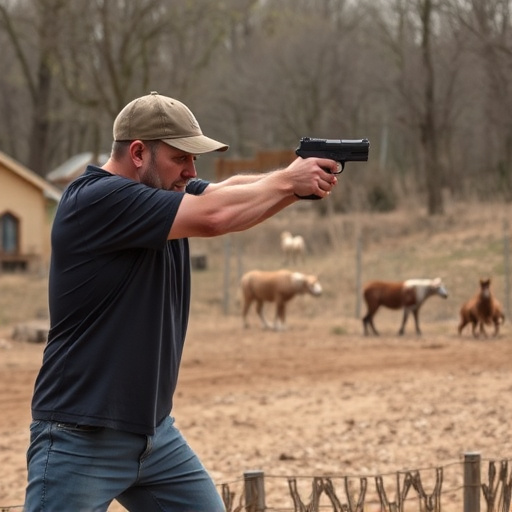Choosing between bear spray and personal pepper spray depends on intended target (wildlife vs humans) and desired range/duration. Bear spray has higher capsaicin levels, wider spray pattern for wildlife deterrence; personal pepper spray focuses on close-quarters human defense with lower capsaicin and precise aiming. Bear spray designed for outdoor conditions, personal pepper spray compact and lightweight with safety mechanisms. Effective use requires training in specific techniques and understanding local laws regarding ownership/deployment.
“Uncover the safety and effectiveness of pepper spray self-defense weapons with our comprehensive guide. Explore the nuances between bear spray, designed for wildlife encounters, and personal pepper spray, tailored for individual protection. Delve into the safety features and design differences that set them apart. Learn about practical use cases, essential training considerations, and legal implications for responsible ownership. Stay prepared, stay safe.”
- Understanding Pepper Spray Types: Bear vs Personal
- Safety Features and Differences in Design
- Effective Use Cases and Training Considerations
- Legal Implications and Responsible Ownership
Understanding Pepper Spray Types: Bear vs Personal
When it comes to self-defense, pepper spray is a popular choice for many due to its non-lethal nature and effectiveness in deterring attackers. However, understanding the difference between bear spray and personal pepper spray is crucial for ensuring safety and proper usage. Bear spray, designed originally for wildlife management and hunting, is formulated to incapacitate larger animals like bears. It uses capsaicin oil in a higher concentration than personal pepper spray, making it more potent but less precise. Personal pepper spray, on the other hand, is tailored for human self-defense scenarios, with lower concentrations of capsaicin to minimize risk of injury while still providing a strong deterrent effect.
The key distinction lies not only in the intended target—bears versus humans—but also in the range and duration of their effects. Bear spray typically has a longer reach and can be effective at a distance, useful when facing aggressive wildlife. Personal pepper spray, while less potent, is designed for close-quarters defense, providing a cloud of irritants to disrupt an attacker’s vision and breathing for a shorter period. Choosing the right type ensures that individuals are prepared for specific situations, whether they involve wild animals or personal safety in urban environments.
Safety Features and Differences in Design
When considering bear spray vs personal pepper spray for self-defense, understanding their safety features and design differences is crucial. Bear spray, designed to deter bears, uses capsaicin in a more concentrated form than personal pepper spray. Its wide spray pattern can cover a larger area, making it effective at a distance, but this concentration also increases the risk of accidental inhalation or eye irritation if not used properly. In contrast, personal pepper spray focuses on close-range defense against human aggressors. It typically has a narrower spray pattern and lower capsaicin concentration, aiming to temporarily blind and disorient the attacker without causing severe health risks.
The design differences are also notable. Bear spray cans often have a robust build to withstand harsh outdoor conditions, while personal pepper sprayers tend to be more compact and lightweight for easy carry. Some models feature advanced safety mechanisms like color-coded triggers or lock features to prevent accidental activation. These distinctions highlight the tailored nature of each spray type, catering to unique self-defense scenarios—one for wildlife encounters and another for personal security in urban environments.
Effective Use Cases and Training Considerations
Pepper spray has proven to be a valuable tool for self-defense, with both bear spray and personal pepper spray finding their uses. When considering effectiveness, personal pepper spray is designed specifically for close-range defense against human aggressors, offering a quick incapacitation through eye irritation and temporary breathlessness. In contrast, bear spray is formulated for repelling larger animals and has a longer range, making it more suitable for outdoor scenarios where wild animals might be a threat.
Training considerations are crucial when equipping individuals with pepper spray. For personal pepper spray, focus on scenarios involving close combat and proper aim to ensure its effectiveness. Bear spray training should include understanding wind conditions, spraying techniques for optimal reach, and post-spray de-escalation tactics due to its wider application and potential for longer-range use. Both types benefit from regular practice to maintain proficiency and confidence in their use.
Legal Implications and Responsible Ownership
When considering pepper spray for self-defense, understanding legal implications and responsible ownership is paramount. Each jurisdiction has specific laws governing the use, possession, and carrying of bear spray (or personal pepper spray). It’s crucial to research local regulations to ensure compliance. Unauthorized possession or misuse could result in severe penalties, including fines or imprisonment.
Responsible ownership involves safe storage, understanding the device’s mechanics, and knowing when to deploy it. Pepper spray should never be used recklessly or without justification. Users must familiarize themselves with their rights and obligations under the law, especially regarding self-defense claims and potential legal repercussions. Bear spray vs. personal pepper spray options further complicate matters, highlighting the need for informed decisions based on individual needs and local laws.
When considering pepper spray for self-defense, understanding the distinctions between bear spray and personal pepper spray is paramount. While both aim to incapacitate an aggressor, their design, effectiveness, and legal standing differ significantly. Personal pepper spray, designed for close-quarters self-defense, offers a range of options for individuals seeking protection. In contrast, bear spray, with its broader radius and longer duration, is optimized for outdoor scenarios involving wild animals. Responsible ownership, proper training, and awareness of local laws are essential when handling any type of pepper spray to ensure safety and effectiveness in real-world situations.
